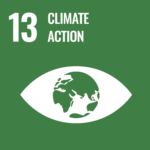Throughout International Development Week, we are tracking progress on environmental sustainability by our projects around the world. From the Caribbean to Africa and Latin America, here is how four Alinea Project Directors are innovating to ensure their projects contribute to achieving SDG 13: Take urgent action to combat climate change and its impacts.
Question: Of the many activities undertaken by your project on climate action, what stands out to you as a key contribution towards achieving SDG 13? Why?
Wit Siemieniuk, Project Director, Disaster Recovery Rapid Response Plan for Overseas Territories Project – Funded by the UK Foreign, Commonwealth & Development Office through the Conflict, Stability & Security Fund
Climate change on a global scale can be difficult to grasp. However, the consequences of climate-related disasters, when they affect us as individuals, are easy to understand. Through this project, which covers six Caribbean islands, we provide the skills and resources necessary to restore infrastructure (roads, airports, ports and telecommunications) and utilities (power and water) to facilitate delivery of relief efforts, minimize disruptions to health services and support the vulnerable. By working towards SDG 13, we proactively minimize the adverse impacts of climate change, while recognizing the need to be able to respond to climate-related disasters when they occur. Planning for the worst while hoping for the best, a fundamental principle of disaster planning, also applies to a proactive approach to climate action through national strategy development, education and awareness raising.
Rick Sunstrum, Project Director, SMIS: Small Scale & Micro Irrigation Support in Ethiopia Project – Funded by the Embassy of the Kingdom of the Netherlands and Global Affairs Canada
To combat climate change and its impacts in Ethiopia, we focused on implementing on-farm water management plans, as well as soil and water conservation plans in 49 SMIS pilot irrigation schemes. This initiative reduced drainage problems caused by heavy rainfall by 65 per cent, as well as associated flood damage to irrigation infrastructure and arable farmland. We also reduced waterlogging of schemes from 70 per cent to less than 20 per cent, and soil erosion due to heavy rainfall and cultivation of fields with steep slopes from 60 per cent to 18 per cent. We also saw increased use of Integrated Pest Management techniques among farmers, which is a core element of sustainable agriculture.
Shantel Jordison, Project Director, Comunica: Building Extractive Sector Governance in Colombia Project – Funded by Global Affairs Canada
Comunica approaches natural resource management through an environmentally sustainable framework, with a key contribution towards achieving SDG 13 being an improvement to transparent and evidence-based decision making within key government institutions. This supports better climate and environmental outcomes in Colombia. A powerful example is Comunica’s partnership with the Colombian Ministry of Mines and National Mining Agency to develop and implement the country’s first-ever Integrated Mining Management System, AnnA Mineria. Sustainability is at the heart of AnnA Mineria. This system empowers decision makers to digitally set and restrict the issuance of mine titles in environmentally sensitive areas, thus conserving thousands of hectares of Colombia’s Amazon rainforest – what many call the “lungs of the planet.”
Brian Fawcett, Project Director, Climate Smart-PSNP: Technical Assistance to Support Global Climate Change Alliance Plus/Mainstreaming of Climate Smart Planning and Implementation Approaches into the Productive Safety Net Program IV in Ethiopia – Funded by the European Commission
Through the Climate Smart-PSNP, we are providing technical assistance to the Government of Ethiopia to mainstream climate-smart approaches across public works and natural resource management agencies and to quantify the carbon sequestration benefits generated by PSNP through community based participatory watershed and rangeland management interventions. A critical challenge is ensuring that annual safety net plans for Ethiopian communities address both environmental vulnerability and community needs, so we introduced comprehensive Climate Vulnerability and Capacity Assessments as a tool to strengthen climate resilient planning at the regional, district and community levels. Using Community Based Participatory Watershed Development and Pastoral Public Works guidelines, the grassroots level is now leading decision-making and planning to combat climate change and its impact across Ethiopia.
In the year ahead, we look forward to implementing innovative solutions to climate change adaptation and mitigation. This may be climate-resilient urban planning and infrastructure to prepare for climate-induced migration, or irrigated agriculture as a gender-transformative approach to climate change adaptation. We also see opportunities for Canadian Climate Finance investments in under resourced climate change sectors where Canada can have the greatest impact, such as precision agriculture, nature based solutions, solar energy, bio-fuels and more. Canada is a global leader in many fields related to climate action and has an opportunity to adapt existing products, technologies and innovations to meet climate change needs around the world. Alinea is pleased to be contributing to Canada’s momentum on climate action.
